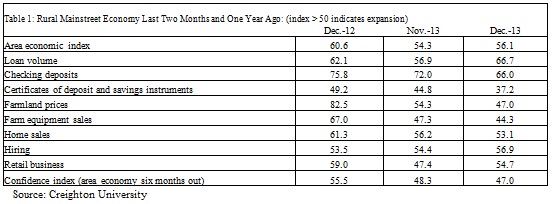The Rural Mainstreet Index (RMI) advanced further above growth neutral this month as bankers believe the rural economy of the U.S., dependent on agriculture and energy, continues to expand at a healthy rate. The farmland price index which has been above growth neutral for almost four years has dropped to slightly below growth neutral.
The Rural Mainstreet Index, ranging between 0 and 100 with 50.0 representing growth neutral, increased to 56.1 from a 54.3 in November. Although the rural economy is growing at a steady pace, there are risks as we enter 2014 as Ernie Goss, economist at Creighton University, points out, "This month we asked bankers to name the biggest threat to the rural economy for 2014. Approximately 80.6 percent named lower agriculture prices to be the greatest economic threat in the next year while 10.6 percent said the Affordable Care Act was the biggest economic challenge for 2014.”
The farmland price index contracted to 47.0, the lowest level since December 2009. Goss noted, “This is the first time in four years that the farmland-price index has moved below growth neutral. As agriculture commodity prices have moved lower, so have farmland prices.”
For the sixth month in a row, farm equipment sales were below growth neutral at 44.3, down three points from last month. "Over the past year, grain prices have declined by roughly 35 percent. This has significantly reduced farmers’ willingness to purchase agriculture equipment,” said Goss.
The loan-volume index increased to 66.7, from November's 56.9. The checking-deposit index fell to 66.0, from 72.0 last month.
Bankers were asked this month what the largest threat to community banks will be as we move into 2014. Over half of bankers believe increased regulatory costs were the number one risk to community banks and a fourth of bankers believe low loan demand to be the largest threat. 
Survey
This survey represents an early snapshot of the economy of rural, agriculturally and energy-dependent portions of the nation. The RMI is a unique index covering 10 regional states, focusing on approximately 200 rural communities with an average population of 1,300. It gives the most current real-time analysis of the rural economy.
- English (UK)
- English (India)
- English (Canada)
- English (Australia)
- English (South Africa)
- English (Philippines)
- English (Nigeria)
- Deutsch
- Español (España)
- Español (México)
- Français
- Italiano
- Nederlands
- Português (Portugal)
- Polski
- Português (Brasil)
- Русский
- Türkçe
- العربية
- Ελληνικά
- Svenska
- Suomi
- עברית
- 日本語
- 한국어
- 简体中文
- 繁體中文
- Bahasa Indonesia
- Bahasa Melayu
- ไทย
- Tiếng Việt
- हिंदी
Rural Economy Grows At Steady Pace
Published 12/23/2013, 05:57 AM
Updated 07/09/2023, 06:31 AM
Rural Economy Grows At Steady Pace
Latest comments
Loading next article…
Install Our App
Risk Disclosure: Trading in financial instruments and/or cryptocurrencies involves high risks including the risk of losing some, or all, of your investment amount, and may not be suitable for all investors. Prices of cryptocurrencies are extremely volatile and may be affected by external factors such as financial, regulatory or political events. Trading on margin increases the financial risks.
Before deciding to trade in financial instrument or cryptocurrencies you should be fully informed of the risks and costs associated with trading the financial markets, carefully consider your investment objectives, level of experience, and risk appetite, and seek professional advice where needed.
Fusion Media would like to remind you that the data contained in this website is not necessarily real-time nor accurate. The data and prices on the website are not necessarily provided by any market or exchange, but may be provided by market makers, and so prices may not be accurate and may differ from the actual price at any given market, meaning prices are indicative and not appropriate for trading purposes. Fusion Media and any provider of the data contained in this website will not accept liability for any loss or damage as a result of your trading, or your reliance on the information contained within this website.
It is prohibited to use, store, reproduce, display, modify, transmit or distribute the data contained in this website without the explicit prior written permission of Fusion Media and/or the data provider. All intellectual property rights are reserved by the providers and/or the exchange providing the data contained in this website.
Fusion Media may be compensated by the advertisers that appear on the website, based on your interaction with the advertisements or advertisers.
Before deciding to trade in financial instrument or cryptocurrencies you should be fully informed of the risks and costs associated with trading the financial markets, carefully consider your investment objectives, level of experience, and risk appetite, and seek professional advice where needed.
Fusion Media would like to remind you that the data contained in this website is not necessarily real-time nor accurate. The data and prices on the website are not necessarily provided by any market or exchange, but may be provided by market makers, and so prices may not be accurate and may differ from the actual price at any given market, meaning prices are indicative and not appropriate for trading purposes. Fusion Media and any provider of the data contained in this website will not accept liability for any loss or damage as a result of your trading, or your reliance on the information contained within this website.
It is prohibited to use, store, reproduce, display, modify, transmit or distribute the data contained in this website without the explicit prior written permission of Fusion Media and/or the data provider. All intellectual property rights are reserved by the providers and/or the exchange providing the data contained in this website.
Fusion Media may be compensated by the advertisers that appear on the website, based on your interaction with the advertisements or advertisers.
© 2007-2025 - Fusion Media Limited. All Rights Reserved.
